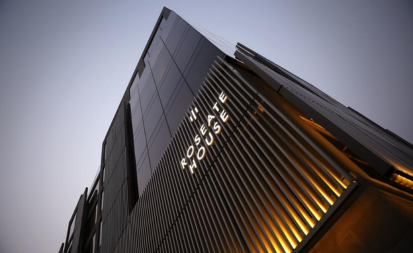Wine has Become an Integral Part of the Hospitality Industry, Enhancing the Overall Guest Experience
Amardeep Singh, General Manager, The Westin Resort & Spa, Himalayas Major factors behind the growth of Wine tourism in India Wine tourism in India has been on the rise in recent years, driven by several factors that

Amardeep Singh, General Manager, The Westin Resort & Spa, Himalayas
Major factors behind the growth of Wine tourism in India
Wine tourism in India has been on the rise in recent years, driven by several factors that have contributed to the growth of the wine industry and the interest of tourists in exploring vineyards and wineries. Major factors behind the growth of wine tourism in India:
1. Increasing Wine Production: India has seen a significant increase in wine production in the past few decades. This growth is due to the establishment of new wineries and vineyards in regions like Nashik (Maharashtra), Karnataka, and Himachal Pradesh. The availability of a variety of wines has attracted wine enthusiasts and tourists.
2. Quality Improvement: Indian wineries have focused on improving the quality of their wines, making them more competitive in the international market. This has led to a growing recognition of Indian wines on the global stage, piquing the curiosity of wine connoisseurs.
3. Scenic Vineyard Locations: Many Indian vineyards are situated in picturesque locations with beautiful landscapes and favorable climates. These scenic settings offer tourists a unique and enjoyable experience as they explore the vineyards and enjoy wine tastings amidst stunning natural beauty.
4. Wine Tours and Tastings: Wineries in India have started offering guided tours and tastings to visitors. These tours provide insights into the winemaking process, from grape cultivation to bottling, and allow tourists to sample a variety of wines, enhancing their understanding and appreciation of wine.
5. Cultural and Culinary Experiences: Wine tourism in India often includes cultural and culinary elements. Visitors can enjoy traditional Indian cuisine paired with local wines, providing a rich and immersive experience that combines wine with regional culture.
6. Festivals and Events: Wine festivals and events, have gained popularity in India. These events showcase wine and music, attracting both domestic and international tourists.
7. Word of Mouth and Social Media: Positive experiences shared by tourists on social media platforms and through word of mouth have contributed to the popularity of wine tourism in India. Recommendations and reviews from fellow travelers have a significant impact on the choices of potential tourists.
In conclusion, the growth of wine tourism in India can be attributed to a combination of factors, including the expansion and improvement of the wine industry, the appeal of scenic vineyard locations, cultural experiences, and changing consumer preferences. As India continues to develop as a wine-producing nation, wine tourism is likely to flourish even further.
How has the placement/ demand of wine in Hotels changed over time?
The placement and demand for wine in hotels have evolved from a limited selection to a diverse and dynamic offering that reflects changing consumer tastes, preferences for local and sustainable products, and a desire for unique and educational experiences. Wine has become an integral part of the hospitality industry, enhancing the overall guest experience:
1. Increased Variety: In the past, many hotels had limited wine selections, often focusing on a few well-known wine regions or brands. Today, there is a greater emphasis on offering a wide variety of wines from different regions, including local and international options. Hotels now feature diverse wine lists to cater to different tastes and preferences.
2. Local Wine Promotion: With the rise of wine production in various regions worldwide, hotels have started to showcase local wines. This “support local” trend has gained momentum as consumers increasingly seek authentic and unique experiences. Hotels may collaborate with nearby wineries and promote local wine as a way to connect with the local culture and community.
3. Wine Education: Many hotels now invest in wine education programs for their staff. This includes training for sommeliers and wait staff to provide knowledgeable recommendations and enhance the overall guest experience. Some hotels even offer wine tasting events and classes for guests.
4. Wine Pairing Menus: To enhance the dining experience, hotels often offer wine pairing menus where each course is matched with a specific wine. This practice has become more sophisticated and is seen as an integral part of fine dining, elevating the status of wine in hotels.
5. Wine Bars and Lounges: Hotels have incorporated wine bars and lounges into their establishments. These dedicated spaces offer an extensive wine selection, providing guests with a relaxed atmosphere to enjoy a glass or bottle of wine. Wine bars are also popular venues for social gatherings and networking events.
6. Wine Dispensing Technology: Some upscale hotels have adopted advanced wine dispensing systems that allow guests to enjoy wine by the glass without opening an entire bottle. These systems preserve the freshness of the wine and enable hotels to offer a wider range of options.
7. Wine Packages and Deals: Hotels often create wine-focused packages and promotions to attract guests. These may include complimentary wine upon arrival, wine-themed weekend getaways, or special discounts on wine purchases for hotel guests.
8. Online Reservations and Wine Lists: Many hotels now provide their wine lists online, allowing guests to peruse the selection before arriving. This transparency helps guests make informed choices and enhances their overall dining experience.
9. Sustainability and Organic Wines: As sustainability and environmental consciousness grow, hotels are increasingly including organic and sustainable wines on their lists. These wines are often promoted as eco-friendly options.
Wine has become an essential part of the menu in today’s dining experience. What are the key factors in managing and serving the diners’ wine options?
Managing and serving wine effectively in a dining establishment is crucial to enhancing the overall dining experience for customers.
1. Well-Trained Staff: Staff, including sommeliers and wait staff, should be well-trained in wine knowledge and service. They should be able to assist customers in selecting wines, provide information about the wine list, and offer food and wine pairing suggestions.
2. Diverse Wine Selection: Offer a diverse wine list that includes a variety of wine styles, regions, and price points. This allows diners to find wines that suit their preferences and budgets.
3. Proper Wine Storage: Ensure wines are stored at the correct temperature and humidity levels to maintain their quality. A wine cellar or temperature-controlled wine storage is essential.
4. Wine Presentation: Present the wine bottle to the customer before opening it. This allows the customer to verify the wine’s label and vintage, ensuring it matches their order.
5. Wine Glasses: Use appropriate wine glasses for different types of wine (e.g., red, white, sparkling). Clean, polished glassware enhances the wine-drinking experience.
6. Wine Service Temperature: Serve wines at the correct temperature. Red wines are typically served slightly cooler than room temperature, while white wines are often served chilled. Sparkling wines should be well chilled.
7. Wine Decanting: Consider decanting certain wines, especially older red wines with sediment or wines that benefit from aeration. Decanting can improve a wine’s flavor and aroma.
8. Wine Pouring: Pour wine with care, ensuring that glasses are not overfilled. A standard pour for wine is typically around 5 to 6 ounces (150-180 ml).
9. Wine Pairing Suggestions: Train staff to offer wine pairing suggestions based on the diner’s food choices. Wine and food should complement each other to enhance the dining experience.
11. Wine by the Glass: Offer a selection of wines by the glass to cater to diners who may not want a full bottle. Rotate these selections regularly to keep the options fresh.
12. Sustainable and Organic Options: Include sustainable and organic wine options on the menu, as these are increasingly popular among environmentally conscious diners.
13 Regular Wine List Updates: Periodically update the wine list to introduce new selections, seasonal wines, or special promotions. Keep it fresh and exciting for returning customers.
14. Wine Events and Tastings: Consider hosting wine events, such as wine tastings or wine-pairing dinners, to engage customers and educate them about wine.
According to you, how has the wine industry evolved over time in terms of supply as well as customer demand? How has it been impactful for your brand?
Evolution of the Wine Industry:
1. Globalization of Wine Supply: The wine industry has seen a significant globalization of supply, with wine production expanding to regions beyond traditional wine-producing countries like France and Italy. New World wine regions, such as Australia, New Zealand, the United States (California), Chile, and South Africa, have emerged as major players in the global wine market.
2. Diverse Wine Styles: The industry has diversified to accommodate a wide range of wine styles, from traditional classics to innovative and experimental wines. This diversity caters to a broad spectrum of consumer tastes and preferences.
3. Sustainable Practices: There is a growing emphasis on sustainability and environmentally friendly practices in grape cultivation and winemaking. This trend reflects the increasing consumer demand for eco-friendly products and responsible business practices.
4. Boutique Wineries: The rise of boutique wineries and small-scale producers has created a niche market for unique and artisanal wines. These producers often focus on quality over quantity and offer distinct, limited-production wines.
5. Technology Integration: Wineries have integrated technology into various aspects of production and marketing. This includes precision viticulture, data analytics, e-commerce, and social media marketing to reach a wider audience and improve operational efficiency.
6. Wine Tourism: Wine tourism has gained popularity, with wineries opening their doors to visitors for tours, tastings, and cultural experiences. This trend has boosted direct-to-consumer sales and brand loyalty.
7. Online Wine Sales: E-commerce has become a significant channel for wine sales, allowing consumers to purchase wine directly from wineries, wine shops, and online marketplaces.
8. Wine Education: Consumers are increasingly interested in wine education and knowledge. Wine education programs, blogs, and social media have played a role in making wine more approachable and accessible.
How is wine at your brand (Hotel, restaurant or airline) playing an essential role in customer experience?
We do serve a variety of fine wines at our resort at our All Day dining restaurant, Library Bar, at our Asian restaurant and also via In-room Dining. We do have well-curated wine lists offering our guests a wide selection of wines that pair perfectly with their menu offerings.
—-
 English
English French
French German
German Italian
Italian




